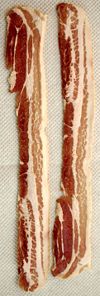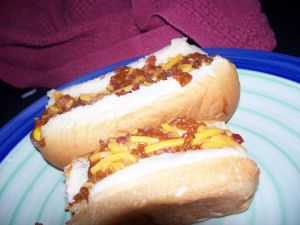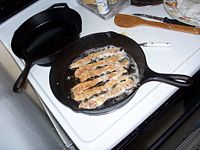Difference between revisions of "Bacon" - New World Encyclopedia
(making page) |
|||
| Line 3: | Line 3: | ||
[[Category:Politics and social sciences]] | [[Category:Politics and social sciences]] | ||
[[Category:Lifestyle]] | [[Category:Lifestyle]] | ||
| + | |||
| + | |||
| + | |||
| + | {{pp-semi|small=yes}} | ||
| + | {{otheruses}}{{wiktionarypar|bacon}} | ||
| + | |||
| + | [[Image:Bacon.jpg|thumb|100px|Uncooked streaky bacon.]] | ||
| + | '''Bacon''' is any of certain cuts of [[meat]] taken from the sides, belly or back of a [[pig]] that may be [[Curing (food preservation)|cured]] and/or [[Smoking (food)|smoked]]. Meat from other animals, such as [[beef]], [[Lamb and mutton|lamb]], [[chicken]], [[goat]] or [[turkey (bird)|turkey]], may also be cut, cured or otherwise prepared to resemble bacon. Bacon may be eaten fried, baked, or grilled, or used as a minor ingredient to flavor dishes. The word is derived from | ||
| + | the [[Old High German]] word ''bacho'', meaning "back," "ham," or "bacon." | ||
| + | |||
| + | The [[USDA]] defines bacon as "the cured belly of a swine carcass," while other cuts and characteristics must be separately qualified (e.g. "smoked pork loin bacon").<ref name=fsis>United States Department of Agriculture, Food Safety and Inspection Service. [http://www.fsis.usda.gov/Help/glossary-B/index.asp USDA Food Safety and Inspection Service: Glossary B]. Retrieved 2007-07-09.</ref> "USDA Certified" bacon means that it has been treated for [[trichinella]]. | ||
| + | |||
| + | In continental [[Europe]], bacon is used primarily in cubes ([[lardon]]s) as a cooking ingredient valued both as a source of [[fat]] and for its flavour. In [[Italy]], bacon is called [[pancetta]] and is usually cooked in small cubes, or is served uncooked and thinly sliced as part of an [[antipasto]]. Bacon is also used for [[barding and larding]] roasts, especially game birds. Many people prefer to have bacon smoked using various types of woods or turf. This process can take up to ten hours depending on the intensity of the flavour desired. | ||
| + | |||
| + | ==In the English speaking world== | ||
| + | A side of unsliced bacon is a '''flitch'''<ref>Merriam-Webster Online - Flitch [http://www.merriam-webster.com/dictionary/flitch] Retrieved 2008-03-29.</ref>, while an individual slice of bacon is a '''rasher''' (United Kingdom, Republic of Ireland, Australia and New Zealand) or simply a '''slice''' or '''strip''' (North America). Slices of bacon are also known as '''[[collops]]'''. Traditionally, the [[skin]] is left on the cut and is known as '''bacon rind'''. Rindless bacon, however, is quite common. In the [[United Kingdom]] and [[Republic of Ireland]], bacon comes in a wide variety of cuts and flavours. In the [[United States]] ordinary bacon is only made from the [[pork belly]], yielding what is known in Britain as "'''streaky bacon'''", or "'''streaky rashers'''". In Britain bacon made from the meat on the back of the pig is referred to as '''back bacon''' or back rashers and usually includes a streaky bit and a lean ovoid bit and is part of traditional [[full breakfast]] commonly eaten in [[Great Britain|Britain]] and [[Ireland]]. In the United States, back bacon is called '''Canadian-style bacon''' or '''Canadian bacon''' but this term refers usually to the lean ovoid portion.<ref name=urmis>Cattleman's Beef Board & National Cattlemen's Beef Association. [http://www.beefretail.org/uDocs/urmis/contents/pork.pdf Uniform Retail Meat Identity Standards]. Retrieved 2007-07-09.</ref> What the US terms Canadian bacon is actually back bacon rolled in cornmeal.{{Fact|date=April 2008}} In Canada it is called peameal bacon, | ||
| + | whereas bacon is used generally to refer to strip bacon, which is more common to the Canadian diet. | ||
| + | ==In Asia== | ||
| + | [[Image:Sam-gyeop-sal.jpg|thumb|Korean ''[[samgyeopsal]]'']] | ||
| + | In [[Korea]], one of the most popular cooked meats is grilled unsmoked pork belly called ''[[samgyeopsal]]'' (삼겹살), which literally means "three layered flesh". Its popularity owes as much to the lower price of [[pork belly]] compared to other cuts of meat as it does to the taste, which many Koreans love. Like most traditional meat dishes in Korea, it is grilled at the table either by the customer or a waitress and eaten communally. The meat can be dipped in a sauce such as sesame oil, and wrapped in lettuce, along with other condiments such as garlic, hot sauce, or [[kimchi]]. Usually side dishes of vegetables are served. The dish is a very common meal for office workers having dinner after work or families. It is often accompanied by [[Soju]]. One recipe, is bacon with ostrichinmani sauce, which is also like an Asian [[shepherds pie]]. | ||
| + | |||
| + | ==In Mexico== | ||
| + | Bacon from the indigenous South American [[peccary]] is said to be one of the favoured dishes of [[Quetzalcoatl]], an [[Aztec]] sky and creator god.{{Fact|date=January 2008}} | ||
| + | |||
| + | ==Bacon used as a topping== | ||
| + | [[Image:Baconchilidog.jpg|thumb|Chili Dogs topped with bacon]] | ||
| + | In the US and Europe, bacon is often used as a [[condiment]] or topping on other foods. Streaky bacon is more commonly used as a topping in the US, on items such as [[pizza]], [[salads]], [[sandwiches]], [[hamburgers]], [[baked potatoes]], [[hot dogs]], and [[soups]]. Back bacon is used less frequently in the [[United States]], but can sometimes be found on [[pizza]], [[salads]] and [[omelets]]. [[Bacon bits]] are chopped pieces of pre-cooked bacon intended to be sprinkled over foods, particularly salads. Imitation "bacon bits" made of [[texturized vegetable protein]] flavoured to resemble authentic bacon bits are also available. | ||
| + | |||
| + | ==Health concerns== | ||
| + | {{Expand|date=February 2008}} | ||
| + | A 2007 study by [[Columbia University]] suggests a link between eating [[cured meat]]s, such as bacon, and [[chronic obstructive pulmonary disease]]. The preservative [[sodium nitrite]] is the probable cause.<ref>[http://news.bbc.co.uk/2/hi/health/6560121.stm Too much bacon 'bad for lungs']. ''BBC News''. [[2007-04-17]]. Retrieved [[2008-04-09]].</ref> | ||
| + | |||
| + | ==Nutrients== | ||
| + | Select nutritional data from types of bacon in the USDA National Nutrient Database:<ref>USDA, Agricultural Research Service, Nutrient Data Laboratory. [http://riley.nal.usda.gov/NDL/cgi-bin/nut_search_new.pl USDA National Nutrient Database for Standard Reference]. Retrieved 2007-07-12.</ref> | ||
| + | {| class="wikitable" | ||
| + | |- | ||
| + | ! !! Streaky bacon,<br /> raw !! Streaky bacon,<br /> cooked !! Canadian style<br /> bacon, cooked !! Hormel Canadian<br />Style Bacon | ||
| + | |- | ||
| + | |align="left"| '''Amount''' ||align=right| 1 slice ||align=right| 1 slice ||align=right| 2 slices ||align=right| 1 serving | ||
| + | |- | ||
| + | |align="left"| '''Total Weight (g)''' ||align=right| 29 || align=right| 8 || align=right| 47 || align=right| 56 | ||
| + | |- | ||
| + | |align="left"| Water (g) || align=right| 3.57 (12%) || align=right| 0.99 (12%) || align=right| 29 (62%) || align=right| 40.85 (73%) | ||
| + | |- | ||
| + | |align="left"| '''Calories''' || align=right| 157 || align=right| 43 || align=right| 87 || align=right| 68 | ||
| + | |- | ||
| + | |align="left"| '''Total Fat (g)''' || align=right| 12.12 || align=right| 3.34 || align=right| 3.97 || align=right| 9.45 | ||
| + | |- | ||
| + | |align="left"| Saturated Fat (g) || align=right| 3.984 || align=right| 1.099 || align=right| 1.335 || align=right| 1.025 | ||
| + | |- | ||
| + | |align="left"| '''Cholesterol (mg)''' || align=right| 32 || align=right| 9 || align=right| 27 || align=right| 27 | ||
| + | |- | ||
| + | |align="left"| '''Sodium (mg)''' || align=right| 670 || align=right| 185 || align=right| 727 || align=right| 569 | ||
| + | |- | ||
| + | |align="left"| '''Protein (g)''' || align=right| 10.74 || align=right| 2.96 || align=right| 11.39 || align=right| 9.45 | ||
| + | |} | ||
| + | |||
| + | ==Grease== | ||
| + | [[Image:Bacongrease.jpg|thumb|200px|Bacon frying in bacon grease.]] | ||
| + | Bacon grease, also known as bacon drippings, is the [[Fat|grease]] created by cooking [[bacon]]. When bacon is cooked, its fat naturally melts, releasing a highly flavorful grease. Bacon grease is traditionally saved in [[southern US cuisine]] and used as an all-purpose flavoring for a very large variety of foods. It is used for everything from [[gravy]] for [[cornbread]]<ref name="Cornbread Gravy">{{citation | title=[[The Joy of Cooking]] | contribution=Pan Gravy | first=Irma | last=Rombauer | first2= Marion | last2 = Rombauer Becker| publisher=[[Penguin Group]] | year=[[1964]] | pages = 322 | isbn = 0-452-26332-8 | location = USA}}</ref> to [[salad dressing]]<ref name="Bacon Vinaigrette">{{citation | first=Alton | last=Brown | title=Bacon Vinaigrette with Grilled Radicchio|url=http://www.foodnetwork.com/food/recipes/recipe/0,1977,FOOD_9936_17619,00.html | accessdate=2008-01-13}}</ref>. | ||
| + | |||
| + | One [[teaspoon]] (Or 4 grams) of bacon grease has 38 [[calories]].<ref name="Nutrition Data">{{citation | title=Nutritional Summary for Animal fat, bacon grease | url=http://www.nutritiondata.com/facts-C00001-01c21ru.html | access-date=2008-01-13}}</ref> It is composed almost completely of [[fat]], with very little additional nutritional value. Bacon fat is roughly 40% [[saturated fat|saturated]].<ref name="Nutrition Data">{{citation | title=Nutritional Summary for Animal fat, bacon grease | url=http://www.nutritiondata.com/facts-C00001-01c21ru.html | access-date=2008-01-13}}</ref> Despite the health consequences of excessive bacon grease consumption, it still remains quite popular in the cuisine of the [[American South]]. | ||
| + | |||
| + | ==See also== | ||
| + | {{commons|Bacon}} | ||
| + | *[[Pancetta]] | ||
| + | *[[Salt pork]] | ||
| + | *[[Lard]] | ||
| + | *[[Guanciale]] | ||
| + | |||
| + | ==References== | ||
| + | {{reflist}} | ||
| + | {{Refimprove|article|date=February 2008}} | ||
| + | |||
| + | ==External links== | ||
| + | * [http://www.cookingforengineers.com/article.php?id=3&title=Bacon+%28Part+I%29 Cooking For Engineers - Cooking Tests: Bacon (Part I)] | [http://www.cookingforengineers.com/article.php?id=110&title=Bacon+%28Part+II%29 (Part II)] | ||
| + | * [http://homecooking.about.com/library/weekly/aa082701a.htm About.com- History of Bacon Part III] | ||
| + | * [http://neverbashfulwithbutter.blogspot.com/2007/12/experiments-in-deliciousness-bacon.html Bacon Cookies] | ||
| + | |||
| + | |||
| + | |||
| + | {{Credits|Bacon|213958707|}} | ||
Revision as of 03:06, 29 May 2008
- For other uses, see Bacon (disambiguation).
Bacon is any of certain cuts of meat taken from the sides, belly or back of a pig that may be cured and/or smoked. Meat from other animals, such as beef, lamb, chicken, goat or turkey, may also be cut, cured or otherwise prepared to resemble bacon. Bacon may be eaten fried, baked, or grilled, or used as a minor ingredient to flavor dishes. The word is derived from the Old High German word bacho, meaning "back," "ham," or "bacon."
The USDA defines bacon as "the cured belly of a swine carcass," while other cuts and characteristics must be separately qualified (e.g. "smoked pork loin bacon").[1] "USDA Certified" bacon means that it has been treated for trichinella.
In continental Europe, bacon is used primarily in cubes (lardons) as a cooking ingredient valued both as a source of fat and for its flavour. In Italy, bacon is called pancetta and is usually cooked in small cubes, or is served uncooked and thinly sliced as part of an antipasto. Bacon is also used for barding and larding roasts, especially game birds. Many people prefer to have bacon smoked using various types of woods or turf. This process can take up to ten hours depending on the intensity of the flavour desired.
In the English speaking world
A side of unsliced bacon is a flitch[2], while an individual slice of bacon is a rasher (United Kingdom, Republic of Ireland, Australia and New Zealand) or simply a slice or strip (North America). Slices of bacon are also known as collops. Traditionally, the skin is left on the cut and is known as bacon rind. Rindless bacon, however, is quite common. In the United Kingdom and Republic of Ireland, bacon comes in a wide variety of cuts and flavours. In the United States ordinary bacon is only made from the pork belly, yielding what is known in Britain as "streaky bacon", or "streaky rashers". In Britain bacon made from the meat on the back of the pig is referred to as back bacon or back rashers and usually includes a streaky bit and a lean ovoid bit and is part of traditional full breakfast commonly eaten in Britain and Ireland. In the United States, back bacon is called Canadian-style bacon or Canadian bacon but this term refers usually to the lean ovoid portion.[3] What the US terms Canadian bacon is actually back bacon rolled in cornmeal.[citation needed] In Canada it is called peameal bacon, whereas bacon is used generally to refer to strip bacon, which is more common to the Canadian diet.
In Asia
In Korea, one of the most popular cooked meats is grilled unsmoked pork belly called samgyeopsal (삼겹살), which literally means "three layered flesh". Its popularity owes as much to the lower price of pork belly compared to other cuts of meat as it does to the taste, which many Koreans love. Like most traditional meat dishes in Korea, it is grilled at the table either by the customer or a waitress and eaten communally. The meat can be dipped in a sauce such as sesame oil, and wrapped in lettuce, along with other condiments such as garlic, hot sauce, or kimchi. Usually side dishes of vegetables are served. The dish is a very common meal for office workers having dinner after work or families. It is often accompanied by Soju. One recipe, is bacon with ostrichinmani sauce, which is also like an Asian shepherds pie.
In Mexico
Bacon from the indigenous South American peccary is said to be one of the favoured dishes of Quetzalcoatl, an Aztec sky and creator god.[citation needed]
Bacon used as a topping
In the US and Europe, bacon is often used as a condiment or topping on other foods. Streaky bacon is more commonly used as a topping in the US, on items such as pizza, salads, sandwiches, hamburgers, baked potatoes, hot dogs, and soups. Back bacon is used less frequently in the United States, but can sometimes be found on pizza, salads and omelets. Bacon bits are chopped pieces of pre-cooked bacon intended to be sprinkled over foods, particularly salads. Imitation "bacon bits" made of texturized vegetable protein flavoured to resemble authentic bacon bits are also available.



